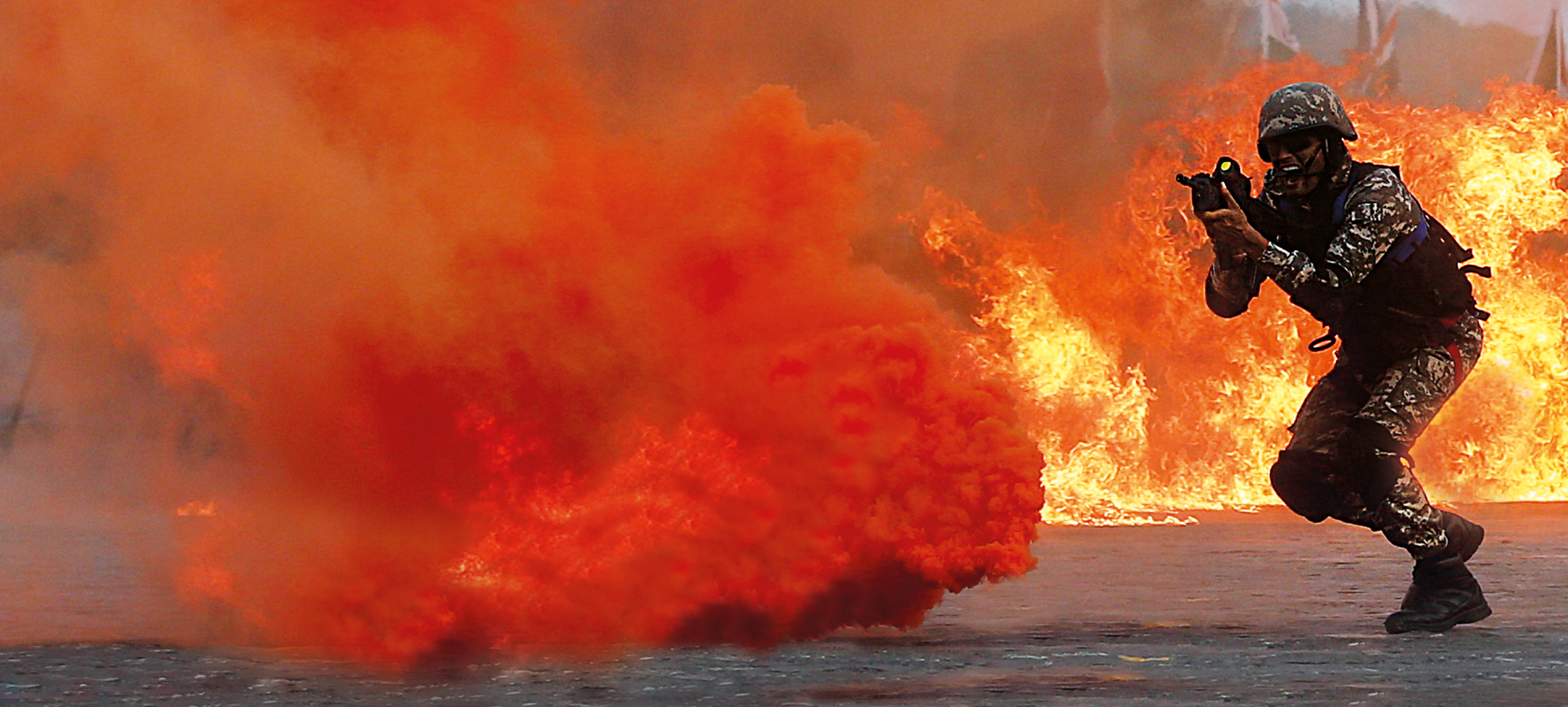
The men who hunted terrorists in a magical Kashmir forest…a pair of young Navy men who gave their all to save their entire submarine crew…the Air Force commando who wouldn’t sleep until he had avenged his buddies…and many more. In this sequel to India’s Most Fearless, authors Shiv Aroor and Rahul Singh offer the reader a poignant insight into a few such instances.
Read an excerpt from the book below:
—
Just after 3.30 a.m. on 26 February 2019, climbing abruptly to 27,000 feet in dark airspace over Pakistan-occupied Kashmir (PoK), an Indian Air Force (IAF) pilot flying in a single-seat Mirage 2000 fighter jet pushed a button on his flight-stick. A few feet below him, from the rumbling belly of his aircraft, an Israeli-made bomb silently detached itself and dropped away to begin a journey—first gliding and then careening— towards a target over 70 km away. The bomb, fed with satellite coordinates and an on-board guidance chip, had all the information it needed to hurtle to its destination.
The Mirage 2000 was far from home. It had taken off from the Gwalior air force base over 1000 km away earlier that night along with at least six more Mirage jets from the three squadrons based there. Over the hour the jets flew over central India and into the northern sector. Following in their wake, five more Mirage 2000 jets took off in the darkness from an air base in Punjab.
The dozen Mirages, flying in three separate and unequal formations, weren’t alone in the air. Two airborne early warning jets, an Embraer Netra from the Bathinda air base and a higher performance Phalcon jet from Agra were already in the air, their powerful radars and sensors on full alert to the mission ahead. Communications between aircraft were kept to a minimum. This was a mission with almost no room for deviation unless absolutely necessary. And it needed to last for as little time as possible.
As the three Mirage formations flew in a circuit at low altitude, very much in the manner of night flying training sorties conducted by squadrons, ten jets more roared off the tarmac from two more air bases, including Sukhoi Su-30 MKI fighters from the forward air base at Halwara. It was this pack of Su-30s that would play a crucial role in what came next.
With a total of twenty-two IAF fighters in the air, the jets slowly mixed their formations to create three separate packs— two mixed packs of Mirage 2000 and Su-30 fighters. And a third pack comprised only of Su-30s. While it’s tempting to think of these three packs as neat little jet formations in the sky, it was nothing quite like that. The jets in each pack flew tens of kilometres from each other, and were only bound by a loose common flightpath and mission profile.
Shortly after 3 a.m., the mission began with a pre-planned deception.
The third fighter pack, consisting of big, heavy Su-30 jets, turned south, heading out of Punjab and into the Rajasthan sector, all the while ensuring it remained prominent and visible to Pakistani radars on the other side of the international border. Turning around over Jodhpur, the fighters began provocatively flying in the direction of the international border north of the Chandan firing ranges, their noses pointed towards a Pakistani city that couldn’t possibly have been on a higher alert at the time—Bahawalpur, 250 km to the north, the city that was home to the Jaish-e-Mohammad’s (JEM’s) headquarters and largest terror training facilities. The IAF planners had counted on Pakistan’s ‘hair-trigger’ state of alert to provoke a reaction. It happened within minutes.
The Pakistan Air Force scrambled a group of F-16 jets from the Mushaf air base in Sargodha about 320 km to the north of Bahawalpur. Just as the jets were getting airborne and moving south to fend off any possible attack by the Indian Su-30s, the second IAF pack, comprising Mirage 2000s and Su-30s, broke away from its circuit and turned south over Jammu along a radial pointed towards Sialkot and Lahore in
Pakistan, both large and commercially important cities. This second pack split further, with one part flying along a radial that would pass through Pakistan’s Okara and lead once again to Bahawalpur.
The twin air manoeuvres from two directions doubled the air threat to the ‘capital city’ of the JeM. More F-16s departed Sargodha to engage with this second Indian threat. Pakistan’s instantaneous scrambling of fighters wasn’t surprising to Indian radar controllers and sensor operators on the two airborne early warning jets. The country’s air defences would have been on their highest state of readiness since the 26/11 Mumbai terror attacks, an act of carnage terrible enough that it got India to seriously consider retaliatory air strikes for the first time.
And now, for twelve days without pause, Pakistan’s military had cranked its alertness levels to maximum.
Eleven days earlier, at 9.30 a.m. on 15 February 2019, the chiefs of the Indian armed forces and intelligence agencies, top ministers and the National Security Advisor arrived at Delhi’s leafy 7, Lok Kalyan Marg compound where the Prime Minister of India lives and sometimes operates from. It was far from a routine weekly meeting for the Prime Minister to take stock of national security.
Eighteen hours earlier, 800 kilometres north, in the Lethapora area of Jammu and Kashmir’s Pulwama district, a vehicle packed with explosives and driven by a young man named Adil Ahmad Dar, had managed to snake between vehicles of a large convoy of Srinagar-bound trucks carrying 2500 troops from the Central Reserve Police Force (CRPF), and rammed it. The explosion killed forty troops, spattering the highway with their blood and body parts. Minutes after the blast, a stream of pictures of the mangled vehicles and sickening carnage taken from mobile phones of locals and first responders flooded social media.
With the Pakistan-administered JeM terror group claiming responsibility for the attack, the Prime Minister had convened this meeting of the Cabinet Committee on Security (CCS) solely to assess how India could respond. Forty minutes later, the meeting was finished. Asked if air strikes on a terror target were a viable option, IAF Chief Air Chief Marshal Birender Singh Dhanoa responded in the affirmative, also briefing the Cabinet Committee that the country’s jets would be ready to strike with confirmed targets in a matter of days. He was given two weeks.
From 16–20 February, the IAF worked with intelligence agencies at the operations room in Delhi’s Vayu Bhawan. With National Security Advisor Ajit Doval receiving a daily update on proceedings, the deliberations were honed by satellite imagery, human intelligence from the ground in Pakistan and PoK, and photographs from a pair of Heron drones flying daily missions along the Line of Control (LoC).
On 21 February, the IAF presented a classified set of ‘target tables’ to the government via the National Security Advisor. The first in the list of seven separate target options was a JeM terror training compound that sat on a hill called Jabba Top outside the city of Balakot in Pakistan’s Khyber- Pakhtunkhwa province. The IAF recommended Balakot, just 100 km from Pakistan’s capital Islamabad, since it was a secluded target with the lowest probability of non-terrorist casualties.
Untold accounts of the biggest recent anti-terror operations, India’s Most Fearless 2, get your own copy today!









